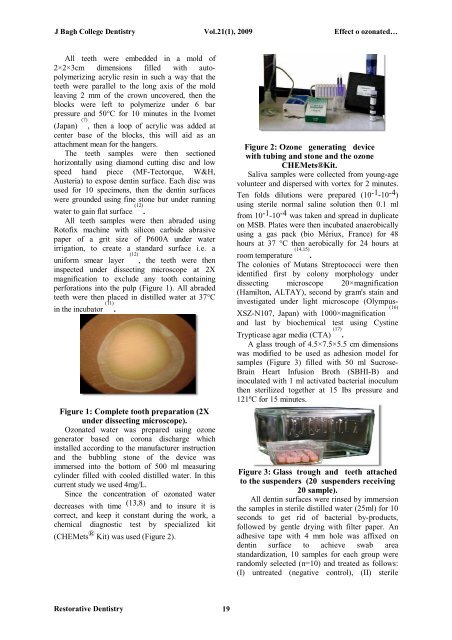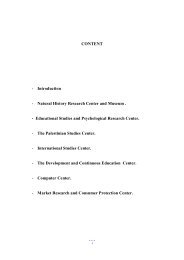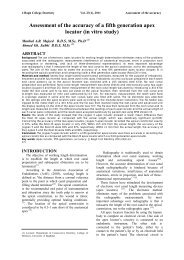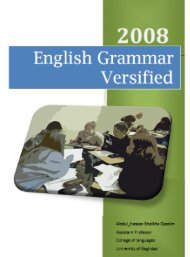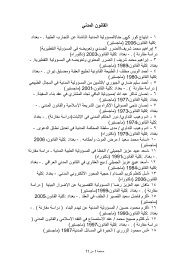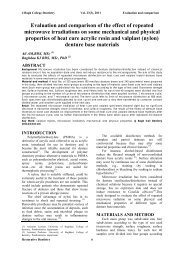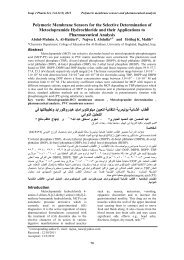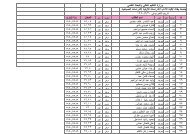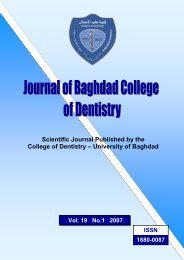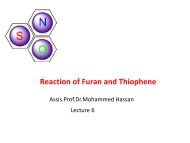Vol 21 No. 1
Vol 21 No. 1
Vol 21 No. 1
Create successful ePaper yourself
Turn your PDF publications into a flip-book with our unique Google optimized e-Paper software.
J Bagh College Dentistry <strong>Vol</strong>.<strong>21</strong>(1), 2009 Effect o ozonated…<br />
All teeth were embedded in a mold of<br />
2×2×3cm dimensions filled with autopolymerizing<br />
acrylic resin in such a way that the<br />
teeth were parallel to the long axis of the mold<br />
leaving 2 mm of the crown uncovered, then the<br />
blocks were left to polymerize under 6 bar<br />
pressure and 50°C for 10 minutes in the Ivomet<br />
(Japan) (7) , then a loop of acrylic was added at<br />
center base of the blocks, this will aid as an<br />
attachment mean for the hangers.<br />
The teeth samples were then sectioned<br />
horizontally using diamond cutting disc and low<br />
speed hand piece (MF-Tectorque, W&H,<br />
Austeria) to expose dentin surface. Each disc was<br />
used for 10 specimens, then the dentin surfaces<br />
were grounded using fine stone bur under running<br />
water to gain flat surface (12) .<br />
All teeth samples were then abraded using<br />
Rotofix machine with silicon carbide abrasive<br />
paper of a grit size of P600A under water<br />
irrigation, to create a standard surface i.e. a<br />
uniform smear layer (12) , the teeth were then<br />
inspected under dissecting microscope at 2X<br />
magnification to exclude any tooth containing<br />
perforations into the pulp (Figure 1). All abraded<br />
teeth were then placed in distilled water at 37°C<br />
in the incubator (11) .<br />
Figure 1: Complete tooth preparation (2X<br />
under dissecting microscope).<br />
Ozonated water was prepared using ozone<br />
generator based on corona discharge which<br />
installed according to the manufacturer instruction<br />
and the bubbling stone of the device was<br />
immersed into the bottom of 500 ml measuring<br />
cylinder filled with cooled distilled water. In this<br />
current study we used 4mg/L.<br />
Since the concentration of ozonated water<br />
decreases with time (13,8) and to insure it is<br />
correct, and keep it constant during the work, a<br />
chemical diagnostic test by specialized kit<br />
(CHEMets ® Kit) was used (Figure 2).<br />
Figure 2: Ozone generating device<br />
with tubing and stone and the ozone<br />
CHEMets®Kit.<br />
Saliva samples were collected from young-age<br />
volunteer and dispersed with vortex for 2 minutes.<br />
Ten folds dilutions were prepared (10 -1 -10 -4 )<br />
using sterile normal saline solution then 0.1 ml<br />
from 10 -1 -10 -4 was taken and spread in duplicate<br />
on MSB. Plates were then incubated anaerobically<br />
using a gas pack (bio Mériux, France) for 48<br />
hours at 37 °C then aerobically for 24 hours at<br />
room temperature (14,15) .<br />
The colonies of Mutans Streptococci were then<br />
identified first by colony morphology under<br />
dissecting microscope 20×magnification<br />
(Hamilton, ALTAY), second by gram's stain and<br />
investigated under light microscope (Olympus-<br />
XSZ-N107, Japan) with 1000×magnification (16)<br />
and last by biochemical test using Cystine<br />
Trypticase agar media (CTA) (17) .<br />
A glass trough of 4.5×7.5×5.5 cm dimensions<br />
was modified to be used as adhesion model for<br />
samples (Figure 3) filled with 50 ml Sucrose-<br />
Brain Heart Infusion Broth (SBHI-B) and<br />
inoculated with 1 ml activated bacterial inoculum<br />
then sterilized together at 15 Ibs pressure and<br />
1<strong>21</strong>ºC for 15 minutes.<br />
Figure 3: Glass trough and teeth attached<br />
to the suspenders (20 suspenders receiving<br />
20 sample).<br />
All dentin surfaces were rinsed by immersion<br />
the samples in sterile distilled water (25ml) for 10<br />
seconds to get rid of bacterial by-products,<br />
followed by gentle drying with filter paper. An<br />
adhesive tape with 4 mm hole was affixed on<br />
dentin surface to achieve swab area<br />
standardization, 10 samples for each group were<br />
randomly selected (n=10) and treated as follows:<br />
(I) untreated (negative control), (II) sterile<br />
Restorative Dentistry 19


